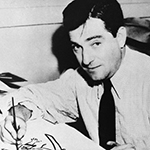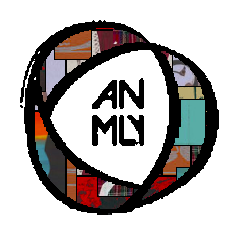Translator’s Note:
As an anti-Zionist Jewish writer working translingually in Yiddish, English, and Hebrew, I am struggling with how to respond to the ongoing genocide in Gaza. Like many Jews throughout history, my first instinct when confronted with tragedy and horror is to turn to the past. I began a disorganized search through the Yiddish Book Center’s archives to find texts I had previously bookmarked as interesting reads that I wanted to explore further. I felt somewhere in the archive of European and American Ashkenazi Jewish culture, I would find the raw materials for a piece that would help me begin to address the questions, swirling inside and outside of me, that I faced as an American Jew against Israeli and Zionist violence. When I came upon the anti-Zionist and anti-imperialist political cartoons by William Gropper for the leftist newspaper Morgn Freiheit reprinted in his collection Di Goldene Medine, This Golden Land (1927), I saw a beginning. I have attempted to collapse translation, historical contextualization, and commentary into one piece of writing. My success in this attempt I leave the reader to decide.
Figure 1

1. This shitty cow!
2. This shitty cow is eating all the money!
3. This shitty cow isn’t doing shit for me!
4. The joke is that this shitty cow is marked Zionist organizations!
5. This shitty cow is standing with its back to a Jew marked the Jew in Exile, or maybe the Jew in Diaspora!
6. This shitty cow eats money and gives money milk!
7. All the money milk flows into Palestine and the Zionist political machine!
8. They don’t even call it Palestine anymore! The shitty cow renamed it Israel! The shitty cow has prohibited us from calling it Palestine!
9. So much for Zionist activity for the Jew in Diaspora! The Jew in Diaspora doesn’t get anything!
10. I’m a Jew in Diaspora! I’m standing behind the shitty cow marked Zionism and all I get is cow shit!
Figure 2

1. The joke isn’t funny if it needs explanation.
2. The joke isn’t funny unless I tell it to you.
3. The joke isn’t funny, it’s a satire.
4. The satire is in the picture.
5. In the picture, two men are waving their fists.
6. The two men look identical and are both Polish, in a sense.
7. In another, more important sense, one is a Jew and the other doesn’t exist.
8. The other exists but he’s many, many people.
9. All of these people who are one person in the picture are antisemites, they’re Polish antisemites. They wear a patriotic uniform and have a big mustache.
10. They say there are too many Jews in Poland.
11. The Jew is named Yitzhak Gruenbaum, and he’s very important in Israel.
12. In Israel, he signed the Declaration of Independence. In Israel, he was the first minister of the interior.
13. In the picture he’s not just some Jew either. He wears a top hat, he wears spats, his Van Dyke beard is slightly overgrown.
14. In Poland, before Israel, when the satire in the picture is drawn, he might be just some Jew, but he works at a newspaper, he’s an editor for a newspaper, several newspapers, in Hebrew and Yiddish. He gets elected to the Sejm, he forms a Jewish bloc, he says the Jews need a homeland in Palestine, over and over and over again.
15. He says that we need more Jews in Palestine.
16. He says there are too many Jews in Poland.
17. The Polish antisemites and the Jew, they speak one language.
18. The language only has one sentence. The sentence is “There are too many Jews in Poland!”
19. But even here they can’t agree. The Polish antisemites are saying “There are too many Jews in Poland!” and the Jew is saying “Too many Jews are in Poland!”
20. What does the difference mean? What does it matter?
21. If Yitzhak Gruenbaum is from Poland and he says there are too many Jews in Poland, is he a Polish antisemite, even though he’s a Jew?
22. Do they speak the same language?
23. Are they the same?
Figure 3

1. The pope is praying.
2. The pope is betraying the workers.
3. The pope is Jewish, that’s why he’s the pope.
4. Let me explain the joke. Let me, a Jew in Diaspora, explain the satire in the picture.
5. Abe Cahan was the editor of the Forward.
6. The Forward was a Yiddish newspaper.
7. The Forward was ideologically Socialist and supported the interests of working Jews.
8. It encouraged them to Americanize in the Bintel Brief, an advice column.
9. The Forward is still a Yiddish newspaper.
10. It is also a Jewish newspaper.
11. Yiddish means Jewish.
12. The Jewish newspaper the Forward publishes in English now as well as Yiddish.
13. One time I, a Jew in Diaspora, got into a fight at a party with an editor of the Jewish newspaper the Forward who told me Yiddish is not a language.
14. She said it was technically a dialect.
15. I said, it’s a language. It’s a language called Yiddish.
16. This was before I spoke Yiddish, but I knew.
17. Anyway, Abe Cahan was the first editor of the Forward, and the Forward was so important they called him the Pope of the Lower East Side.
18. When Abe Cahan went to Palestine in 1925, he was very impressed. He was so impressed that the Forward took a strong Zionist turn.
19. When I, a Jew in Diaspora, lived in Israel for three years, I got very sick. I got so sick, I took a strong turn away from Zionism after leaving Israel.
20. Because I took a strong turn away from Zionism, I stopped reading the Forward in 2017 or so, around when I got into a fight with the editor of a Yiddish newspaper who believes that Yiddish is not a language.
21. When the Forward took a strong Zionist turn, it convinced many American Jews to take a strong Zionist turn.
22. They believed the Forward because the Forward was ideologically Socialist and had supported their interests as working Jews.
23. In the picture, where the satire is, Abe Cahan, the Pope of the Lower East Side, is praying at the Kotel, the Wailing Wall, in Palestine. He holds an edition of the Bintel Brief. At his feet, discarded, are idealism, Socialism, and the interests of the workers.
Figure 4

1. The marine could be going anywhere.
2. The marine is walking through the backdoor, gun drawn, bayonet raised.
3. The marine is marked Yankee Imperialism.
4. He could be going anywhere.
5. I, a Jew in Diaspora, really mean that.
6. I researched all these drawings, all these satire in pictures, and I can’t figure out where the Marine is going.
7. When I looked up “US Marines deployed 1920s” and the range of dates when this cartoon could have been drawn, it was impossible to know where the Marine is going.
8. He could be going to Nicaragua or China.
9. He could be in Micronesia or Guam or the Dominican Republic.
10. The Marine goes through the backdoor, and who knows where he’s going?

William Gropper (1897-1977) was a radical leftist Yiddish and English language American cartoonist, muralist, lithographer, and painter. Gaining recognition in his early twenties for his remarkable drawing style, he went on to have a successful career in a variety of newspapers and publications, including the New York Tribune and Vanity Fair, as well as many notable left-wing publications, such as the Masses, the Liberator, and Morgn Freiheit. His WPA and Treasury Relief Art murals endure in some historic federal buildings. More information about Gropper and his estate can be found at Gropper.com.

Mordecai Martin is a 5th generation Ashkenazi Jewish New Yorker, a psychiatric survivor/Mad person, an aspiring translator of Yiddish poetry and prose, and a writer. He lives in Washington Heights with his wife, child, and Pharaoh-Let-My-People-Go the cat. His work has appeared in Peach Magazine, Catapult, Honey Literary, the tiny magazine, and Longleaf Review. He is pursuing an MFA at Randolph College, blogs at MordecaiMartin.net, and is on social media @mordecaipmartin.

 BACK TO ISSUE
BACK TO ISSUE